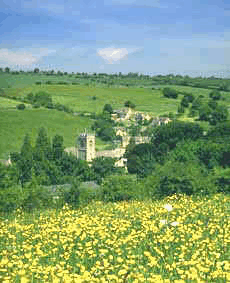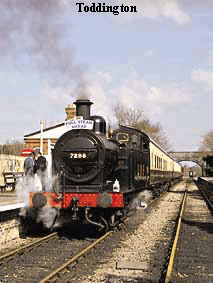|
|
 |
 |
|
 |
|
 |
|
|
|
Gloucestershire, a west Midland county, situated upon the estuary of the Severn, and bounded north and north-east by Herefordshire, Worcestershire, and
Warwickshire; by Oxfordshire; south by Berks, Wilts, and Somerset; and west by
Monmouthshire, Herefordshire, and the estuary of the Severn; greatest length, south-west to north-east 54 miles; greatest breadth, north-west to south-east, 33 miles; area, 783,699
acres; population 572,433. The face of the county shows varied aspects, of which the most distinctive are the Cotswold Hills, in the east; the valley of the Severn, in the middle; and the
Forest of Dean, in the west. Besides the Severn there are numerous important rivers, such as the Avon, Lower Avon, Wye, Thames, and Windrush. The canal system has been largely developed, and several
important water-ways of that description pass through the county. Agriculture forms the leading occupation of the rural population; in the hills
sheep-farming receives attention; while the rich valley of the Severn has long been famed for the superiority of its products. by Oxfordshire; south by Berks, Wilts, and Somerset; and west by
Monmouthshire, Herefordshire, and the estuary of the Severn; greatest length, south-west to north-east 54 miles; greatest breadth, north-west to south-east, 33 miles; area, 783,699
acres; population 572,433. The face of the county shows varied aspects, of which the most distinctive are the Cotswold Hills, in the east; the valley of the Severn, in the middle; and the
Forest of Dean, in the west. Besides the Severn there are numerous important rivers, such as the Avon, Lower Avon, Wye, Thames, and Windrush. The canal system has been largely developed, and several
important water-ways of that description pass through the county. Agriculture forms the leading occupation of the rural population; in the hills
sheep-farming receives attention; while the rich valley of the Severn has long been famed for the superiority of its products.  Its luxuriant pastures especially have originated and supported a great industry in the shape of dairy farms which produce the celebrated
Glo'ster cheese. In the west of the county are 2 great coal fields - the Forest of Dean on the north, and the Bristol coal-field on the west. Other minerals are gypsum, barytes, quartz, limestone, and
freestone. The manufactures are mostly woollen and cotton stuffs, but at Bristol there are also large hardware manufactures." (Bartholomew's Gazetteer of the British Isles, 1887.) Its luxuriant pastures especially have originated and supported a great industry in the shape of dairy farms which produce the celebrated
Glo'ster cheese. In the west of the county are 2 great coal fields - the Forest of Dean on the north, and the Bristol coal-field on the west. Other minerals are gypsum, barytes, quartz, limestone, and
freestone. The manufactures are mostly woollen and cotton stuffs, but at Bristol there are also large hardware manufactures." (Bartholomew's Gazetteer of the British Isles, 1887.) |
|